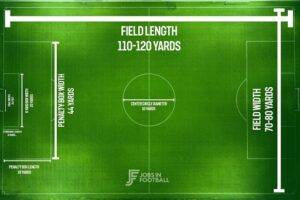Soccer, known as the beautiful game, is played and cherished worldwide. One of the fundamental aspects influencing the dynamics of the game is the size of the soccer field. In this comprehensive guide, we will delve into the dimensions of a soccer field, exploring regulations, variations, and the impact of these dimensions on the game.
Understanding Standard Soccer Field Dimensions

Soccer fields come in various sizes, but there are standardized dimensions set by governing bodies like FIFA. These regulations ensure consistency in the game globally. The standard dimensions for a soccer field are as follows:
- Length:
- The length of a soccer field typically ranges between 100 to 110 yards (300 to 330 feet).
- FIFA mandates a minimum length of 100 yards and a maximum of 110 yards.
- Width:
- The width of a soccer field is usually between 50 to 100 yards (150 to 300 feet).
- FIFA sets a minimum width of 50 yards and a maximum of 100 yards.
Impact of Field Size on Gameplay:
The size of a soccer field has a significant impact on the style of play. Here’s how field dimensions influence the game:
- Pitch Size and Playing Style:
- A larger field encourages a more possession-oriented game, emphasizing ball control and strategic positioning.
- Smaller fields often lead to quicker transitions and a more direct, fast-paced style of play.
- Fitness and Endurance:
- Larger fields require players to cover more ground, demanding higher levels of endurance.
- Smaller fields may lead to more intense, physically demanding matches.
- Strategic Considerations:
- Teams often adapt their strategies based on field dimensions, with some focusing on width and others on compactness.
Variations in Soccer Field Sizes:
While FIFA provides standard dimensions, local variations exist based on factors such as available space and regional preferences:
- Youth Soccer Fields:
- Youth soccer fields are typically smaller to accommodate the physical capabilities of young players.
- Dimensions for youth fields can vary, but they are generally more compact than standard sizes.
- Indoor Soccer Fields:
- Indoor soccer fields have different dimensions due to space constraints.
- These fields are usually smaller, promoting a faster-paced and dynamic style of play.
Key Considerations for Soccer Field Construction:
Whether constructing a new field or refurbishing an existing one, several considerations are vital:
- Drainage and Turf Quality:
- Proper drainage is crucial to prevent waterlogging and maintain a playable surface.
- High-quality turf ensures a consistent playing experience.
- Markings and Goal Posts:
- Accurate field markings and appropriately sized goal posts are essential for fair play.
- Ensure goal posts meet safety standards to prevent injuries.
Understanding the size of a soccer field goes beyond measurements; it’s about appreciating the nuances that make each match unique. Whether playing on a vast stadium pitch or a smaller community field, the dimensions play a pivotal role in shaping the beautiful game we all love.

